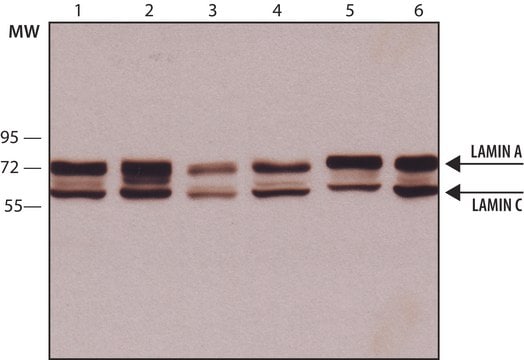MABT1341
Anti-Lamin A/C Antibody, clone 4C11
clone 4C11, from mouse
Synonyme(s) :
70 kDa Lamin, Renal carcinoma antigen NY-REN-32
About This Item
Produits recommandés
Source biologique
mouse
Forme d'anticorps
purified immunoglobulin
Type de produit anticorps
primary antibodies
Clone
4C11, monoclonal
Espèces réactives
human, monkey, Syrian hamster, rat, mouse
Conditionnement
antibody small pack of 25 μg
Technique(s)
ChIP: suitable
immunofluorescence: suitable
immunoprecipitation (IP): suitable
western blot: suitable
Isotype
IgG2aκ
Numéro d'accès NCBI
Numéro d'accès UniProt
Modification post-traductionnelle de la cible
unmodified
Informations sur le gène
human ... LMNA(4000)
Catégories apparentées
Description générale
Spécificité
Immunogène
Application
Cell Structure
Dot Blot Analysis: A representative lot detected Lamin A/C in Dot Blot applications (Roblek, M., et. al. (2010). PLoS One. 5(5):e10604).
Immunocytochemistry Analysis: A 1:1,000 dilution from a representative lot detected Lamin A/C in HeLa cells.
Western Blotting Analysis: A representative lot detected Lamin A/C in WB used to demonstrate high titration and excellent properties of clone 4C11 (Courtesy of Marie lang, M.D., Stefan Schuchner, Ph.D. and Egon Ogris, M.D., Medical University of Vienna, Austria).
Immunofluorescence Analysis: A representative lot detected the Lamin A/C species at the nuclear lamina of HeLa cells (Courtesy of Marie Lang, M.D., Stefan Schuchner, Ph.D. and Egon Ogris, M.D., Medical University of Vienna, Austria).
Immunoprecipitation Analysis: A representative lot detected Lamin A/C in WB used to demonstrate high titration and excellent properties of clone 4C11 (Courtesy of Marie Lang, M.D., Stefan Schuchner, Ph.D. and Egon Ogris, M.D., Medical University of Vienna, Austria).
Chromatin Immunoprecipitation (ChIP) Analysis: A representative lot detected Lamin A/C in Chromatin Immunoprecipitation applications (Gesson, K., et. al. (2016). Genome Res. 26(4):462-73).
Immunofluorescence Analysis: A representative lot detected Lamin A/C in Immunofluorescence applications (Roblek, M., et. al. (2010). PLoS One. 5(5):e10604).
Immunoprecipitation Analysis: A representative lot immunoprecipitated Lamin A/C in Immunoprecipitation applications (Gesson, K., et. al. (2016). Genome Res. 26(4):462-73).
Qualité
Western Blotting Analysis: 0.2 µg/mL of this antibody detected Lamin A/C in HeLa cell lysate.
Description de la cible
Forme physique
Stockage et stabilité
Autres remarques
Clause de non-responsabilité
Not finding the right product?
Try our Outil de sélection de produits.
Code de la classe de stockage
12 - Non Combustible Liquids
Classe de danger pour l'eau (WGK)
WGK 1
Point d'éclair (°F)
Not applicable
Point d'éclair (°C)
Not applicable
Certificats d'analyse (COA)
Recherchez un Certificats d'analyse (COA) en saisissant le numéro de lot du produit. Les numéros de lot figurent sur l'étiquette du produit après les mots "Lot" ou "Batch".
Déjà en possession de ce produit ?
Retrouvez la documentation relative aux produits que vous avez récemment achetés dans la Bibliothèque de documents.
Notre équipe de scientifiques dispose d'une expérience dans tous les secteurs de la recherche, notamment en sciences de la vie, science des matériaux, synthèse chimique, chromatographie, analyse et dans de nombreux autres domaines..
Contacter notre Service technique








